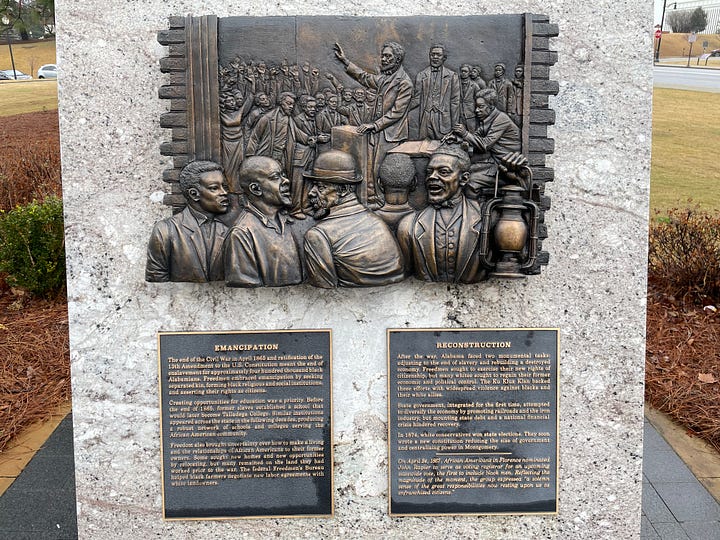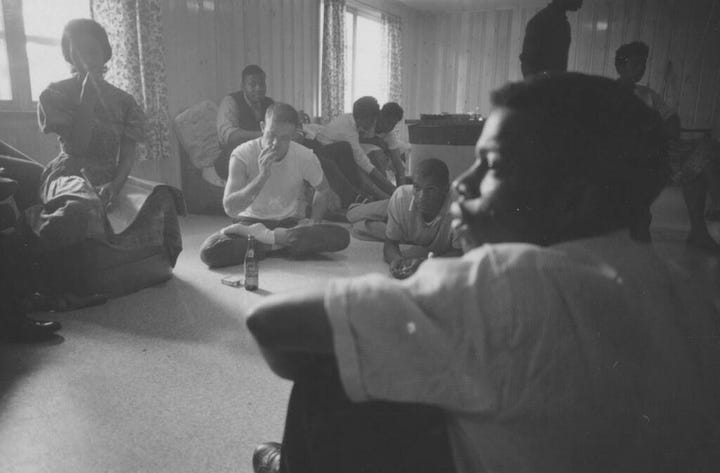Last night I returned from my 5-day civil rights journey with the Jewish Federation of Greater Washington. It was an incredible trip filled with visits to key historic sites and interviews with people who shared their own personal memories of the movement.
For now I am just going to share a few observations.
The new Legacy Museum in Montgomery is a must see. It is located on the site of one of the largest cotton mills in the city. The overall interpretation compliments EJI’s nearby lynching memorial and the organizations commitment to reforming the nation’s criminal justice system.
To have a site devoted to the history of slavery, lynching, the convict lease system and the modern carceral state is invaluable, but I worry that the museum will leave visitors with an interpretation that reduces African Americans to victims. My hope is that a visit to this museum is coupled with a stop at the Rosa Parks Museum, which does a pretty good job of exploring the grass roots Montgomery Bus Boycott.
As a guide I always enjoy leading groups around Montgomery. It offers a rich commemorative landscape in which museums, monuments and other sites devoted to civil rights are now in conversation with a much older and more entrenched Lost Cause footprint.
The slave market, located at a circle on Commerce Street, was recently claimed by the local Black Lives Matter movement. I love this street mural, which now rings the site.


There is a historical marker for the slave market, but it is almost hidden away across the street. It should be relocated at the circle itself so no one misses it.
The new Bicentennial Park located across from the state capitol captures 200 years of Alabama history and offers a refreshingly honest interpretation of slavery, the Civil War, Reconstruction, and Jim Crow.




Of course, a statue of Jefferson Davis and a massive Confederate monument still look down on the city.
Selma is one of the toughest places for me to visit. The urban blight and poverty is always a distraction to the rich history that this city has to offer. The physical condition of the city was magnified even more by the damage caused by a recent tornado.
Most tour groups spend a few hours in town. They may visit the Brown Chapel AME, where the marches over the bridge began, walk the Edmund Pettus Bridge and the visitor center, but that’s about it. The city benefits very little financially from tourism. There are a small number of restaurants and hotels located close to the bridge, but there is little incentive to change things.
I would love to include an appropriate community outreach component for future trips.


This trip also raised for me the question of who should tell the story of the civil rights movement.
In Selma and elsewhere there are plenty of people who lived through the history that we are there to see. While in town our tour employed the help of Terry Chestnut, the son of J.L. Chestnut Jr., the first Black lawyer in the city, who was central to the events that took place there in 1965. Terry looked on with his father on “Bloody Sunday” as John Lewis and others were clubbed and beaten by police.
These are their stories and their perspective is invaluable to understanding the lived experience, but participants aren’t always the best people to narrate what took place as well as the broader context.
The need to reach out to local residents is even more important in a place like Selma, where local guides rely financially on their tour offerings.
For me the highlight of this particular trip was meeting Bernard Lafayette, a member of the Nashville Student Movement and who worked closely with SNCC. He is best known as a strong advocate for non-violent confrontation. Lafayette joined the Freedom Riders in 1961 and was severely beaten, along with John Lewis and William Barbee, in Montgomery. The group narrowly escaped and were given shelter at the Harris House.
I’ve only seen the Harris house—located just up the street from the MLK parsonage home—from the outside, but on Wednesday I had a chance to talk directly with Dr. Lafayette inside the home. At 82 he is still incredibly sharp and charismatic. He described his time with the other Freedom Riders inside the Harris House, but he also talked about his continued commitment to teaching non-violent confrontation across the world.
It actually took me a few moments to reorient myself as I heard him talk about his post-civil rights experiences. Guess I had frozen him in time in my mind.




I will not soon forget this meeting with one of my all-time civil rights era heroes.
That sense of awe was present in Birmingham’s 16th Street Baptist Church, where we talked with Carolyn McKinstry—one of the survivors of the 1963 bombing.
I was struck by Dr. McKinstry’s admission that it took 20 years before she talked about her experience that day, even with close friends and family. It was a reminder that many of the survivors of the movement continue to live with trauma, but it was also encouraging to see these survivors thriving and continuing to work to make their communities a better place.
Over the next few weeks I will likely share more reflections about my trip. For now I am grateful to the D.C. Federation for giving me the opportunity to share my passion for history with their community. I am especially grateful to the participants who shared their reflections and wisdom with me—conversations that often ran into the early morning hours.
I can’t help but point out that this trip took place at the same time that state legislators, including Alabama, are pushing to restrict the study of this history, but there is really nothing to fear.
The worst thing that can happen on such a trip is your heart and mind will be opened.





Wonderful narrative and accompanying photos.
Looking forward to reading and seeing more from your tour.
“I am especially grateful to the participants who shared their reflections and wisdom with me—conversations that often ran into the early morning hours.” Wonderful, thank you